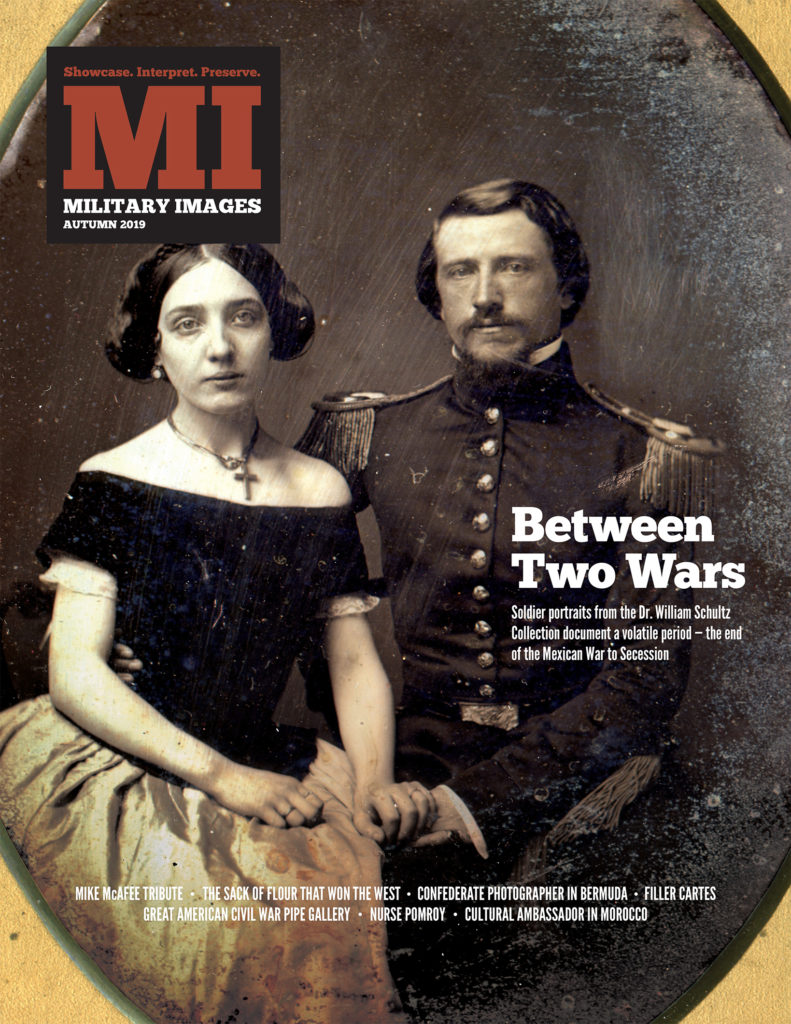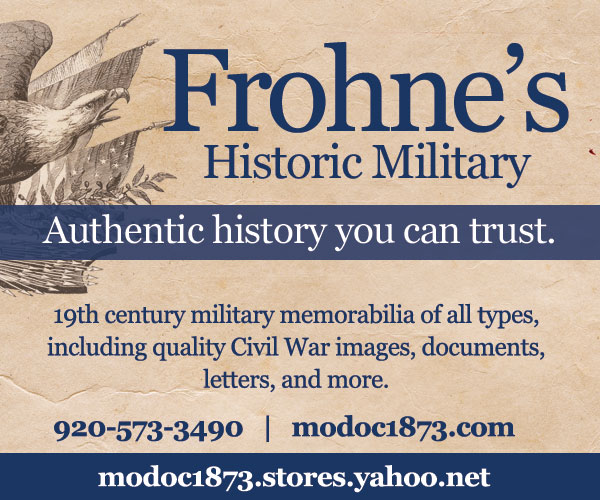The complete issue

Vol. XXXVII, No. 4
(80 pages)
Print edition: Visit our store to check availability
Digital edition: Visit JSTOR.org to purchase
Subscribe to MI ($24.95)
Explore the MI Archives: Browse | Advanced search | Tutorial
Inside
Cover image
A sixth-plate daguerreotype from the Dr. William Schultz Collection pictures an officer wearing an 1851 regulation dress uniform and a woman who wears a cross around her neck.
Download (free)
Table of Contents (p. 1)
Download (free)
Editor’s Desk (p. 2)
The editor recalls to the late Michael J. McAfee, a longtime columnist for MI and a giant in the community of collectors.
Download (free)
Mail Call (pp. 3-4)
Feedback includes tributes to Mike McAfee, the backstory about the discovery of the daguerreotype of general and future president Franklin Pierce published in the last issue.
Download (free)
Military Anthropologist (p. 4)
A look at the number of active duty army and navy personnel in the U.S. military between 1848 and 1861.
Passing in Review (p. 6)
Behind the Rifle: Women Soldiers in Civil War Mississippi by Shelby Harriel (University Press of Mississippi), and The Maryland Brigade by Daniel Carroll Toomey (Toomey Press).
Download (free)
Photo Sleuth by Kurt Luther (pp. 8-10)
In “Evidence-Based Tips for Using Civil War Photo Sleuth,” Kurt discusses how two forms of automation, face recognition and filtering military records, eliminate potential portraits and narrow the possible choices to identify an individual.
Antebellum Warriors (p. 12)
A sixth-plate daguerreotype from the Dr. William Schultz Collection is a portrait of an infantryman dressed in the blue fatigue jacket from 1836 and a Model 1840 officer’s sword.
The Honored Few (p. 14)
Samuel Cole Wright suffered numerous wounds and injuries during his four years in uniform with the 3rd and 29th Massachusetts infantries. During his service in the last-named regiment, he was wounded in both legs during the fighting at the Battle of Antietam’s Bloody Lane. He received the Medal of Honor for his courage.
Most Hallowed Ground (p. 14)
John William Fenton, a captain in the 132nd New York Infantry, was brought up on charges after he assaulted the owner of a saloon in New Bern, N.C., in late 1864. His actions resulted in a dishonorable discharge, which was overturned after his comrades petitioned to allow him to resign with honor. His post-war life took him to Washington, D.C., where he died in 1891 and was buried in Arlington National Cemetery.
The Citizenry by Ron Field(p. 18)
The Haley brothers opened a store in New Market, N.H., on the eve of the Civil War. The building, pictured in this wartime stereo card, produced fatigue blouses and coats for several state regiments. A crowd is gathered in front of the store.
Fakes, Forgeries and Frauds by Perry Frohne (pp. 20-21)
In his inaugural column, “Develop Your Sixth Sense for Fakes,” Perry tells the origin story of fakes, and discusses resources to help you combat fake images with knowledge.
Between Guadalupe Hidalgo and Secession: A survey of military portraits of West Pointers and Regulars on the western frontier by Dr. William Schultz (pp. 22-30)
This is the second in a multi-part series of pre-Civil War military portrait photography from the collection of Dr. William Schultz. Included are several men who went on to serve in the Union and Confederate armies—Confederate surgeon Robert Little Brodie, Capt. Martin Mullins of the 5th U.S. Infantry, and Union generals George Crook, Henry Prince and Henry Walton Wessels.
The Great American Civil War Pipe Gallery (pp. 31-38)
Tobacco was hailed as the soldier’s constant companion—when he could find it—by some and also as a wicked habit by others. In this gallery, a companion to last autumn’s cigar feature, we celebrate those who enjoyed the soldier’s and sailor’s solace in front of the camera.
Cultural Ambassador: On diplomacy’s front lines in Morocco and elsewhere with Albert L. Gihon, U.S. Navy by Ronald S. Coddington (pp. 40-45)
Gihon, a career navy officer, hailed from a family of adventurers that included his father, who participated in the California Gold Rush, and his brother, a prominent Philadelphia photographer. Gihon’s adventures took him to the coast of North Africa, where he and his shipmates on the St. Louis played a role in U.S.-Moroccan diplomacy.
Captured by the Lens in Bermuda: The Confederate Photography of S.W. Gault by Fred D. Taylor (pp. 46-50)
Tennessee’s Samuel Walter “S.W.” Gault traveled the U.S. as a photographer before the war, and when hostilities erupted between the North and South, he set out for Bermuda to avoid the conflict. But he could not escape the far reaches of the Civil War—and a rare opportunity to capture Confederates with his camera.
Corporal Austin Captures a Flag by Ron Field (p. 51)
Albert Austin and his comrades in the 8th Connecticut Infantry had their baptism under fire at the Battle of New Bern, N.C., on March 14, 1862. On that day, Austin picked up a war trophy. Here, we bring together the relic and his portrait—and tell Austin’s story.
Nurse Pomroy: Comforter-in-Chief to the Lincoln Family by Chris Foard, MSN, RN (pp. 52-57)
Rebecca Pomroy came to Washington to take care of wounded and sick soldiers. Much to her surprise, she was called to care for the Lincoln family—a role that she enjoyed, but also one that challenged her because it kept her from the soldier boys she pledged to serve.
Filler Cartes de Visite: A fresh look at art, humor and satire by James S. Brust (pp. 58-65)
In recent times, cartes de visite of art, celebrities, scenes and other non-personal portraits tucked into albums have been labeled as “fillers.” The term implies that they were less desirable afterthoughts. The opposite is true. We tell you why.
Hard Drinking Colonels: A tableau of two commanders of the 69th Ohio Infantry by David B. Holcomb (pp. 66-67)
A tintype of four soldiers provides an entry point into the early and troubled history of the 69th Ohio Infantry, which involved two colonels with alcohol problems.
The Little Sack of Flour That Won the West by Jeremy Rowe (pp. 68-70)
What began as a bet on a mayoral race in a rough and tumble Nevada mining town ended with mock auctions across the West for a sack of flour that raised huge amounts of money to support Union troops. The man who led the philanthropic effort, merchant Reuel Colt “R.C.” Gridley, was an unlikely fundraiser.
The Entertainer: Long before Bob Hope entertained the troops, there was Barney Williams by Kraig McNutt (pp. 71-74)
The popular Irish singer and stage star, along with his wife, Maria, made a fortune and achieved celebrity status before the Civil War. After hostilities began, Barney brought much needed cheer to Union soldiers. President Abraham Lincoln was a fan—and John Wilkes Booth was not.
Stragglers: Distinctive Images from MI contributors (pp. 78-79)
Included is a portrait of the brothers Henry and William King, enlisted men in the 52nd Pennsylvania Infantry, a Union infantryman with an Austrian Lorenz rifle musket, and two casually-dressed federals pictured just days before their Suffolk, Va., garrison came under siege by Confederates.
The Last Shot (p. 80)Two cartes de visite from the Karl Sundstrom Collection picture Union officers, each with a pencil inscription that accuses one of gambling and the other of cowardice.




































